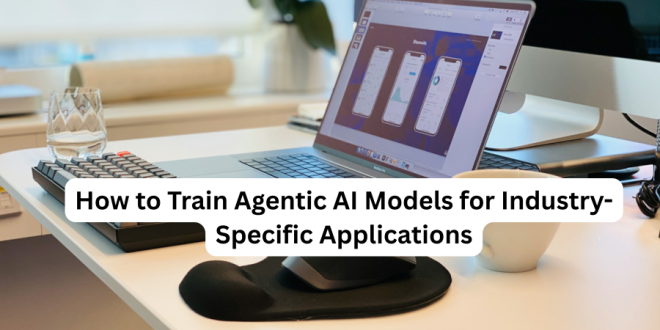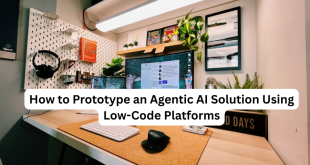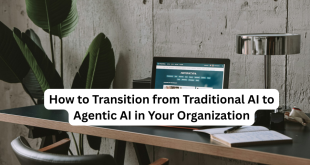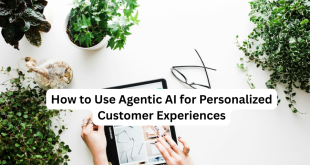Agentic AI—autonomous systems that make decisions and execute tasks with minimal human oversight—is revolutionizing industries from healthcare to logistics. Unlike traditional AI, agentic AI acts proactively, adapting to dynamic environments. But to unlock its potential, you need to train these models for your specific industry. This guide walks you through the process, step by step, ensuring your agentic AI is tailored to your unique needs.
Why Industry-Specific Training Matters
Generic AI models often fall short in specialized contexts. A logistics company needs AI to optimize routes in real time, while a hospital requires precise patient triage. Industry-specific training aligns agentic AI with your workflows, data, and goals, delivering actionable results. For example, Gartner predicts that by 2028, 15% of daily work decisions will be made autonomously, but only if models are trained effectively.
Here’s how to train agentic AI models for your industry:
Step 1: Define Your Objectives and Use Case
Start by pinpointing what you want your agentic AI to achieve. Ask:
- What problem will it solve? (e.g., predictive maintenance in manufacturing, fraud detection in finance)
- What decisions should it make autonomously? (e.g., rerouting deliveries, flagging suspicious transactions)
- What are the success metrics? (e.g., reduced downtime by 20%, 95% accuracy in detections)
Example: A retail chain might aim for an AI agent that autonomously adjusts inventory based on sales trends and supplier delays.
Pro Tip: Document constraints like regulatory compliance (e.g., HIPAA for healthcare) or real-time processing needs to guide your training.
Step 2: Collect and Prepare Industry-Relevant Data
Agentic AI thrives on high-quality, domain-specific data. Here’s how to get it right:
- Source Data: Gather data from your industry’s operations—patient records for healthcare, shipment logs for logistics, or transaction histories for finance. Include structured (databases) and unstructured (text, images) data.
- Clean Data: Remove duplicates, correct errors, and handle missing values. Tools like Pandas or OpenRefine can streamline this.
- Label Data: For supervised learning, label data to teach the AI (e.g., “urgent” vs. “non-urgent” for medical cases). Use crowdsourcing platforms or in-house teams.
- Contextualize Data: Ensure the data reflects real-world scenarios, like seasonal demand spikes in retail or traffic patterns in logistics.
Example: A logistics firm might collect GPS data, delivery times, and weather reports, labeling delays as “weather-related” or “traffic-related.”
Pro Tip: Synthetic data generation (using tools like Synthea for healthcare) can fill gaps when real data is limited or sensitive.
Step 3: Choose the Right Model Architecture
Agentic AI often combines reinforcement learning (for decision-making) with deep learning (for pattern recognition). Select a model based on your use case:
- Reinforcement Learning (RL): Ideal for tasks like route optimization, where the AI learns by trial and error. Libraries like Stable-Baselines3 are great starting points.
- Large Language Models (LLMs): For text-heavy tasks like customer service automation, fine-tune models like Llama or GPT with industry-specific prompts.
- Multimodal Models: For industries like manufacturing, where AI processes images (e.g., defect detection) and sensor data, use models like CLIP or DALL-E.
Example: A healthcare provider might use an RL model to prioritize patient cases, combined with an LLM to interpret medical notes.
Pro Tip: Start with pre-trained models from platforms like Hugging Face to save time, then customize them for your industry.
Step 4: Fine-Tune the Model
Fine-tuning adapts a general model to your specific data. Follow these steps:
- Split Data: Divide your dataset into training (70%), validation (20%), and test (10%) sets.
- Set Parameters: Adjust hyperparameters like learning rate or batch size. Use tools like Optuna for automated tuning.
- Train Incrementally: Feed your industry data into the model, monitoring performance on the validation set.
- Mitigate Bias: Check for biases (e.g., skewed patient demographics) and balance datasets if needed.
Example: A finance firm might fine-tune an LLM to detect fraudulent transactions by training it on historical fraud cases, adjusting for rare but critical patterns.
Pro Tip: Use transfer learning to leverage pre-trained models, reducing training time and computational costs.
Step 5: Simulate Real-World Scenarios
Agentic AI must handle dynamic, unpredictable environments. Test its decision-making in simulated settings:
- Build Simulations: Use tools like AnyLogic or Unity to mimic industry conditions (e.g., supply chain disruptions, patient influx).
- Stress-Test: Expose the AI to edge cases, like sudden demand surges or system failures.
- Evaluate Autonomy: Measure how often the AI makes correct decisions without human input.
Example: A logistics company could simulate a snowstorm delaying deliveries, testing if the AI reroutes trucks effectively.
Pro Tip: Reinforcement learning environments like OpenAI Gym can help create custom simulations.
Step 6: Deploy and Monitor
Once trained, deploy your agentic AI in a controlled environment:
- Integrate with Systems: Connect the AI to your CRM, ERP, or IoT platforms using APIs.
- Start Small: Pilot the AI in one department or region to catch issues early.
- Monitor Performance: Track KPIs like accuracy, response time, and cost savings. Use dashboards (e.g., Grafana) for real-time insights.
- Iterate: Retrain the model periodically with new data to adapt to changing conditions.
Example: A hospital might deploy an AI to triage patients in one ward, monitoring how it prioritizes cases compared to human staff.
Pro Tip: Implement a human-in-the-loop system for high-stakes decisions, allowing overrides if needed.
Step 7: Address Ethical and Regulatory Concerns
Industry-specific AI must comply with regulations and ethical standards:
- Ensure Transparency: Log the AI’s decisions for audits (e.g., why it flagged a transaction).
- Protect Privacy: Use anonymization or federated learning for sensitive data, especially in healthcare or finance.
- Stay Compliant: Align with laws like GDPR, CCPA, or industry standards like ISO 27001.
Example: A finance AI must explain fraud detection decisions to comply with anti-money laundering regulations.
Pro Tip: Consult legal experts early to avoid costly rework.
Tools and Resources to Get Started
- Data Prep: Pandas, OpenRefine, Synthea
- Model Training: TensorFlow, PyTorch, Hugging Face
- Simulation: OpenAI Gym, AnyLogic, Unity
- Monitoring: Grafana, Prometheus
- Cloud Platforms: AWS SageMaker, Google Cloud AI, Azure AI
Challenges and How to Overcome Them
- Data Scarcity: Use synthetic data or transfer learning.
- High Costs: Opt for open-source tools or cloud-based pay-as-you-go services.
- Skill Gaps: Train staff with online courses (e.g., Coursera, Udemy) or hire specialists.
Conclusion
Training agentic AI for industry-specific applications is a game-changer, enabling autonomous, efficient workflows. By defining clear objectives, curating relevant data, and fine-tuning models with real-world testing, you can deploy AI that drives measurable impact. Start small, iterate often, and stay mindful of ethics and compliance. With the right approach, your industry-specific agentic AI can lead the way in 2025’s tech landscape.
 UBUCH ubuch | Honest Tech Reviews & Tutorials for Everyone
UBUCH ubuch | Honest Tech Reviews & Tutorials for Everyone




